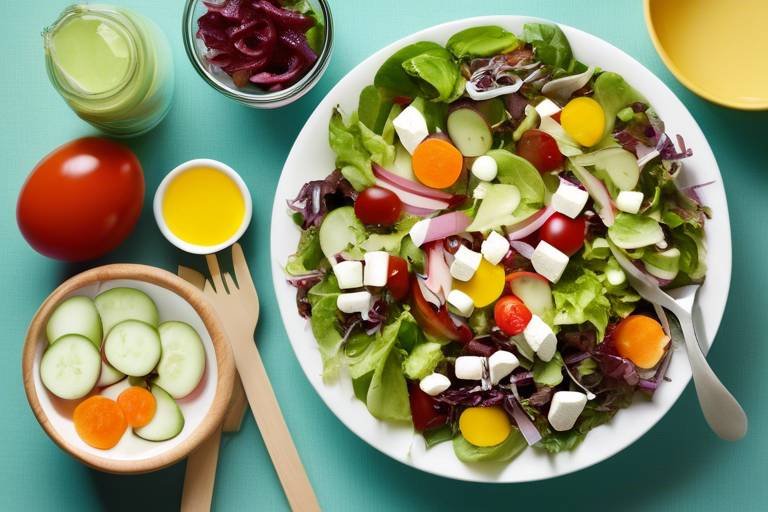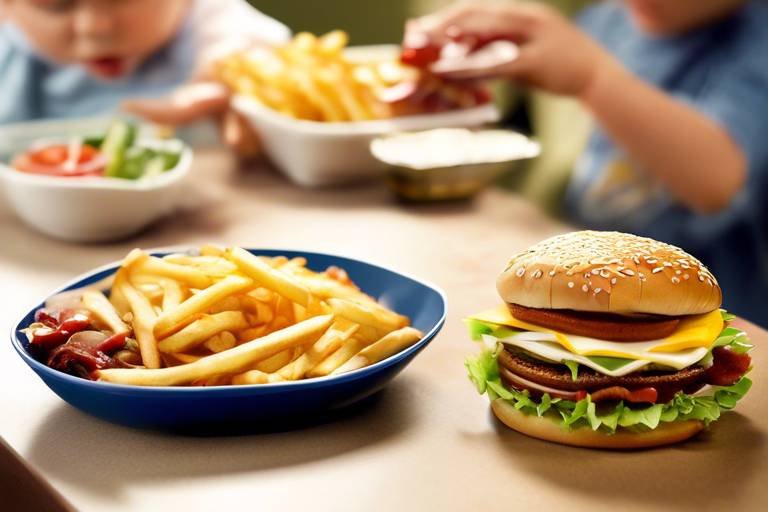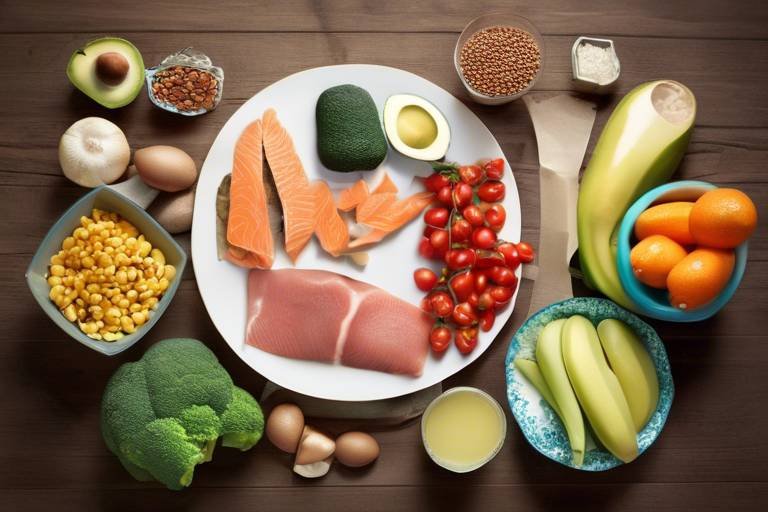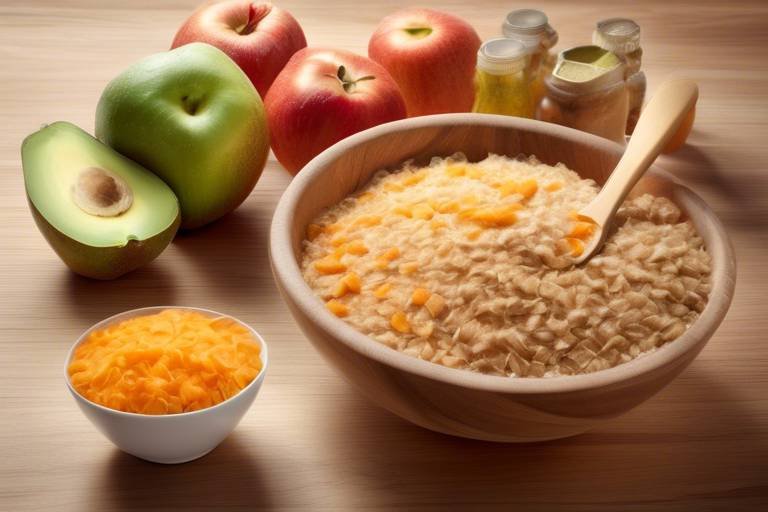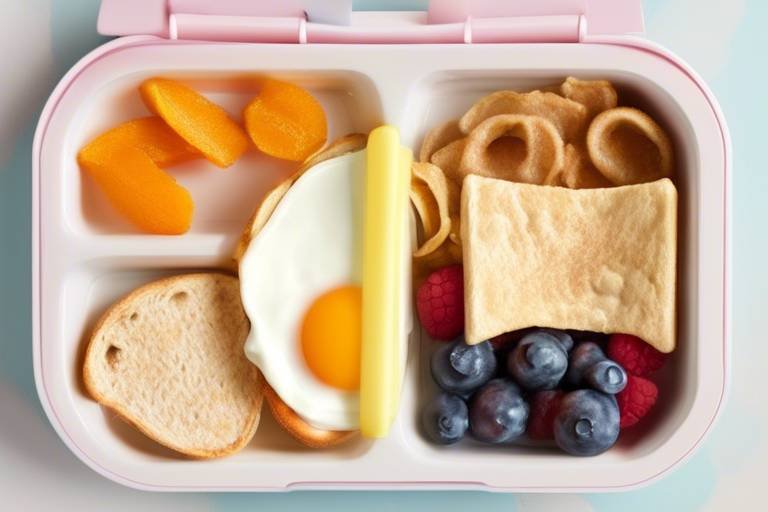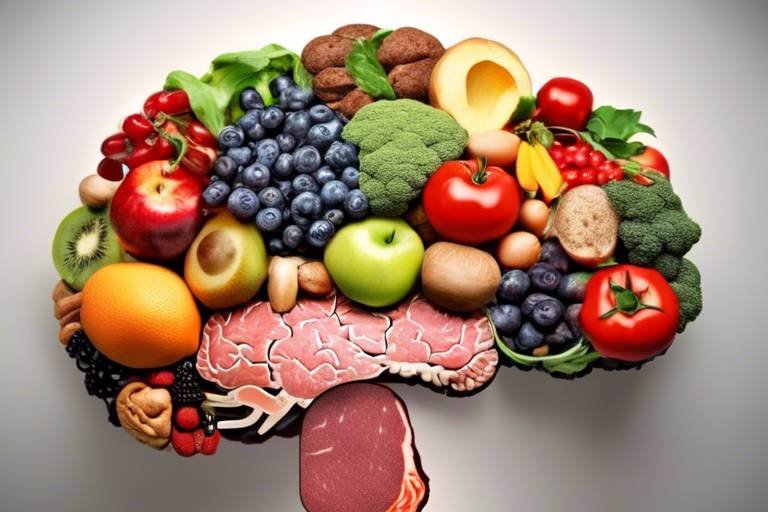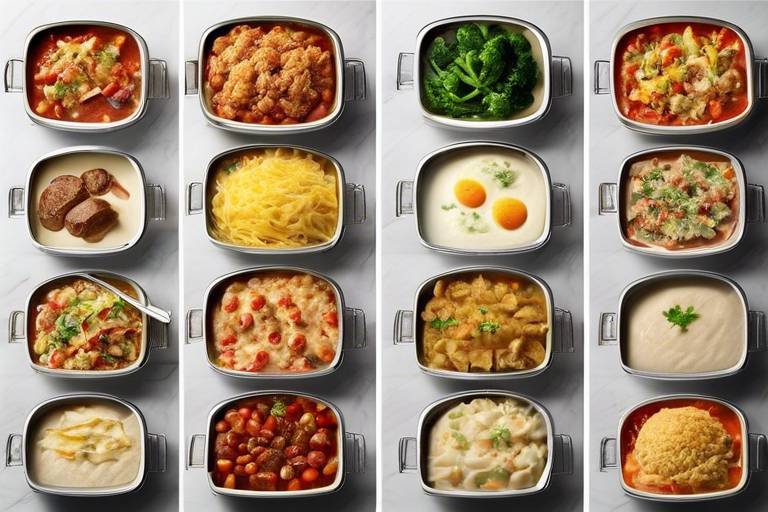How to Meal Prep for a Busy Week
In today's fast-paced world, juggling work, family, and social commitments can feel like a never-ending circus. Wouldn't it be amazing if you could save time and eat healthier without sacrificing flavor? Meal prepping is your ticket to a smoother week! By dedicating just a few hours to prep your meals, you can enjoy delicious, nutritious food without the daily hassle of cooking. In this article, we'll explore practical strategies for effective meal prepping, helping you streamline your cooking process and make your busy week a breeze.
Before diving into the nitty-gritty of meal prep, it's essential to grasp the fundamental concepts. Meal prepping involves preparing meals in advance, allowing you to have healthy options ready to go when life gets hectic. The benefits are numerous: you save time, reduce stress, and often eat healthier because you’re less tempted to grab fast food on the go. To get started, gather some essential tools:
- Quality food storage containers
- Sharp knives for efficient chopping
- Measuring cups and spoons
- A reliable meal plan
With these basics in place, you’re well on your way to establishing a successful meal prep routine tailored to your lifestyle!
Creating a weekly menu is crucial for effective meal prep. Think of it as your roadmap for the week. Without a plan, you may find yourself staring at a fridge full of ingredients, unsure of what to do with them. Start by selecting recipes that excite you and ensure that you’re balancing nutrition. A well-planned menu should include a variety of proteins, vegetables, and grains to keep things interesting. Here’s a quick guide to help you:
- Choose at least three different proteins (like chicken, beans, and fish)
- Incorporate a rainbow of vegetables for vitamins and minerals
- Include whole grains like quinoa or brown rice
- Don't forget healthy fats, such as avocados or nuts
By mixing it up, you’ll look forward to your meals instead of dreading them!
When it comes to meal prepping, selecting healthy recipes is key. You want meals that not only nourish your body but also please your palate. Look for recipes that are packed with flavor and can be easily scaled for batch cooking. Websites and apps dedicated to meal planning can be a goldmine for finding nutritious options that cater to your dietary preferences. Remember, healthy doesn’t have to mean bland! Think of spices and herbs as your culinary best friends.
Using seasonal ingredients not only enhances flavor but also supports local farmers. Fresh produce in season is often more nutrient-dense and flavorful. For example, summer brings juicy tomatoes and vibrant bell peppers, while fall offers hearty squash and crisp apples. By incorporating seasonal ingredients, you’ll elevate your meals and enjoy the best that nature has to offer!
Understanding macronutrients is essential for a well-rounded diet. Each meal should contain a balance of proteins, carbohydrates, and fats to ensure sustained energy throughout the week. A simple way to remember this is the "plate method": fill half your plate with vegetables, a quarter with protein, and the remaining quarter with whole grains. This balance will keep you feeling satisfied and energized!
Batch cooking is an efficient way to prepare multiple meals at once. Think of it as cooking for an army, but in reality, you’re just cooking for yourself! Start by selecting a few recipes that can share ingredients, which minimizes waste and saves time. Techniques like roasting, grilling, or slow cooking can be your best friends here. For example, roast a large tray of vegetables and grill chicken at the same time. This not only saves time but also allows flavors to meld beautifully.
Proper storage is vital for meal prep success. Invest in quality containers that are microwave-safe and leak-proof. Labeling your meals can save you from the dreaded “mystery meal” syndrome. Use a simple labeling system with the meal name and date. Here’s a quick overview of storage tips:
| Container Type | Best For |
|---|---|
| Glass containers | Reheating and freezing |
| Plastic containers | Short-term storage |
| Freezer bags | Soups and stews |
With the right storage solutions, your meals will stay fresh and organized throughout the week!
Freezing meals can extend their shelf life and save time. But how do you ensure they retain flavor and texture when reheated? Start by allowing your meals to cool completely before freezing. Use airtight containers or freezer bags to prevent freezer burn. Soups, stews, and casseroles freeze exceptionally well, while cooked grains can be portioned and frozen for quick additions to meals later on.
Reheating meals correctly is crucial for maintaining quality. The goal is to bring your meals back to life without sacrificing taste or nutrition. For most meals, the microwave is a quick option, but for dishes like casseroles, consider using the oven to help retain texture. Add a splash of water or broth before reheating to keep things moist. Remember, a little care in reheating can make your meal feel freshly made!
Q: How long can I store meal preps in the fridge?
A: Generally, meal preps can last in the fridge for about 3-5 days. Make sure to check for any signs of spoilage.
Q: Can I freeze all types of meals?
A: While many meals freeze well, avoid freezing dishes with high water content, like salads, as they may lose texture upon thawing.
Q: How do I avoid getting bored with my meal prep?
A: To keep things exciting, rotate your recipes weekly and try to incorporate different flavors and cuisines. Experiment with new ingredients!

Understanding Meal Prep Basics
Meal prepping might sound like a daunting task, but it’s really just about organizing your meals ahead of time to make your week smoother and healthier. Imagine walking into your kitchen on a busy Monday and feeling like a culinary superhero because you’ve already got delicious, nutritious meals ready to go. That’s the magic of meal prep! It’s not just about cooking; it’s about creating a system that works for you.
So, why should you consider meal prepping? Well, there are several benefits that can transform your relationship with food and cooking:
- Time-Saving: Spend a few hours on the weekend to save countless hours during the week.
- Healthier Choices: Control your ingredients and portion sizes, making it easier to eat well.
- Less Stress: Eliminate the daily scramble of figuring out what to eat.
- Cost-Effective: Buy in bulk and reduce food waste, saving money in the long run.
To get started with meal prepping, you don’t need fancy gadgets or a professional kitchen. A few essential tools can make a world of difference. Think of your kitchen as your own little workshop. Here’s a quick list of must-haves:
- Quality Containers: Invest in a set of durable, leak-proof containers. Glass containers are great for reheating, while plastic ones are lightweight and easy to store.
- Measuring Cups and Spoons: Precision can help you balance out those macronutrients effectively.
- Sharp Knives: A good knife can make chopping and prepping ingredients a breeze.
- Cutting Board: Essential for keeping your workspace clean and organized.
Once you have your tools ready, it’s time to dive into the planning phase. Think of it as mapping out your culinary adventure for the week. Start by choosing a day (like Sunday) to dedicate to meal prep. This is when you’ll cook, portion, and store your meals. A good rule of thumb is to prepare meals that can last for up to five days in the fridge or can be frozen for later use.
As you embark on your meal prep journey, remember to keep your lifestyle and preferences in mind. Are you a vegetarian? Do you have food allergies? Tailoring your meal prep to fit your unique needs will make the process more enjoyable and sustainable. Plus, it’s a fantastic way to explore new recipes and ingredients, keeping your meals exciting and varied.
In summary, understanding the basics of meal prep is all about creating a system that saves you time, money, and stress while helping you make healthier choices. With the right tools and a little planning, you can turn meal prepping into a fun and rewarding routine. So, roll up your sleeves, put on your favorite apron, and get ready to transform your week!

Planning Your Weekly Menu
When it comes to meal prepping, is like laying the foundation for a sturdy house. Without that solid base, everything else can crumble under the pressure of a busy schedule. So, how do you go about crafting a menu that not only saves you time but also keeps your taste buds dancing? Let's dive in!
First off, you want to consider your nutritional needs. Are you aiming to boost your protein intake? Or perhaps you want to incorporate more vegetables into your diet? Understanding your dietary goals is the first step in creating a balanced menu. Think of it like a puzzle; each piece (or meal) needs to fit together to form a complete picture. A well-rounded menu typically includes:
- Proteins: Think chicken, tofu, or legumes.
- Carbohydrates: Whole grains, sweet potatoes, or quinoa.
- Fruits and Vegetables: Seasonal produce is always a winner!
- Healthy Fats: Avocados, nuts, and olive oil can add flavor and nutrition.
Next, consider the variety of meals throughout the week. Eating the same thing every day can get boring faster than you can say "meal prep." To keep your meals exciting, try to rotate different proteins, grains, and vegetables. For example, if you have grilled chicken one day, switch it up with a hearty lentil stew the next. This not only keeps your palate interested but also ensures you're getting a wide range of nutrients.
Another tip is to choose recipes that complement each other. For instance, if you're making a big batch of roasted vegetables, you can use them in a salad, as a side dish, or even blended into a soup later in the week. This way, you maximize your ingredients and minimize waste, which is a win-win!
Now, let’s talk about time management. Set aside a specific day for planning and shopping. Many people find Sundays to be the perfect day to map out their week. Grab a pen and paper (or your favorite app) and jot down your meals. You might want to create a simple table to visualize your week. Here’s a quick example:
| Day | Breakfast | Lunch | Dinner |
|---|---|---|---|
| Monday | Overnight oats | Quinoa salad | Grilled chicken with veggies |
| Tuesday | Smoothie bowl | Leftover quinoa salad | Lentil stew |
| Wednesday | Egg muffins | Wraps with roasted veggies | Stir-fried tofu and rice |
By visualizing your meals in this way, you can easily spot any gaps in nutrition or variety. Plus, it makes grocery shopping a breeze since you’ll know exactly what you need. Speaking of grocery shopping, don't forget to make a list based on your menu. This will save you time in the store and help you avoid those impulse buys that can derail your healthy eating plans.
Lastly, remember that meal prepping is all about flexibility. Life happens, and sometimes you might not feel like eating what you planned. That's okay! Having a few backup meals or ingredients on hand can help you stay on track without feeling restricted. Think of it as having a safety net; it gives you peace of mind knowing you're prepared for anything the week throws your way.
In conclusion, planning your weekly menu is an essential part of successful meal prep. By focusing on nutrition, variety, and strategic planning, you can create a menu that not only nourishes your body but also delights your taste buds. So grab that pen, get creative, and start mapping out your delicious week ahead!
Q: How do I know what recipes to choose?
A: Start by considering your dietary goals and preferences. Look for recipes that are nutritious, easy to prepare, and can be made in batches.
Q: Can I meal prep for just a few days?
A: Absolutely! Meal prepping doesn’t have to be a week-long commitment. You can prep for just a few days if that suits your schedule better.
Q: What if I don’t have time to cook?
A: Consider batch cooking on a less busy day or utilizing quick-cooking methods like stir-frying or using a slow cooker to save time.

Choosing Nutritious Recipes
When it comes to meal prepping, the heart of your success lies in . But how do you know which recipes are both healthy and delicious? It’s like finding a needle in a haystack, right? Well, fear not! With a few guiding principles, you can easily select meals that will not only nourish your body but also tantalize your taste buds. Start by focusing on recipes that incorporate a variety of ingredients. Think of your plate as a colorful palette—each color represents different nutrients. The more colors you include, the more vitamins and minerals you’re likely to consume.
One effective strategy is to look for recipes that are rich in whole foods. This means opting for ingredients that are as close to their natural state as possible. For instance, instead of using white rice, consider brown rice or quinoa; they’re packed with fiber and nutrients. Similarly, choose fresh vegetables over canned ones to avoid excess sodium and preservatives. If you’re unsure where to start, consider the following key components when selecting your meals:
- Protein Sources: Lean meats, legumes, tofu, and fish are fantastic options.
- Whole Grains: Quinoa, brown rice, farro, and oats can be great staples.
- Healthy Fats: Avocados, nuts, seeds, and olive oil add flavor and nutrition.
- Fruits and Vegetables: Aim for a variety of colors to boost your nutrient intake.
Another tip is to consider your dietary preferences and any restrictions you might have. This is where personalizing your meal prep becomes essential. If you’re following a vegetarian or vegan diet, there are countless recipes that focus on plant-based ingredients without sacrificing flavor. Don’t hesitate to experiment with spices and herbs; they can transform a simple dish into something extraordinary. As you explore different recipes, you might even find some hidden gems that become your go-to favorites.
Lastly, don’t forget about the importance of meal variety. Eating the same meals every week can get boring, and we all know that boredom can lead to unhealthy choices. To keep things exciting, try to incorporate a mix of cuisines and flavors into your meal prep. For instance, you could have a Mediterranean quinoa salad one day and a spicy Thai stir-fry the next. By keeping your meals diverse, you’ll look forward to each one and stay motivated throughout the week.
In summary, choosing nutritious recipes is all about balance, variety, and personal preference. By focusing on whole foods, considering your dietary needs, and keeping your meals exciting, you’ll be well on your way to a successful meal prep routine. Now that you have a solid foundation for selecting recipes, let’s move on to how to incorporate seasonal ingredients for an even more flavorful experience!

Incorporating Seasonal Ingredients
When it comes to meal prepping, one of the most delightful strategies you can adopt is . Not only does this approach enhance the flavor of your meals, but it also supports local farmers and promotes sustainability. Imagine biting into a juicy, sun-ripened tomato in summer or savoring the crispness of freshly harvested squash in autumn. The difference in taste is like comparing a home-cooked meal to a frozen dinner—there's just no contest!
Seasonal ingredients are typically fresher, more nutritious, and less expensive than their out-of-season counterparts. When fruits and vegetables are in season, they are harvested at their peak ripeness, which means they are bursting with flavor and nutrients. For instance, consider the vibrant greens of spring, like asparagus and spinach, which are packed with vitamins and minerals. By focusing on these ingredients, you can create meals that are not only delicious but also nutrient-dense.
So, how do you go about finding and using seasonal ingredients? A great starting point is to familiarize yourself with what’s in season in your area. Many farmers' markets and grocery stores provide lists of seasonal produce, making it easier for you to plan your meals. For example, you might discover that in the summer, you can enjoy:
- Tomatoes
- Zucchini
- Corn
- Bell Peppers
In contrast, winter brings a different bounty, including:
- Root vegetables like carrots and potatoes
- Winter squash
- Brussels sprouts
- Dark leafy greens
By incorporating these seasonal ingredients into your meal prep, you can keep your meals exciting and varied. Not only does this practice help you avoid the boredom of eating the same thing week after week, but it also encourages you to experiment with new recipes and flavors. Think about making a hearty vegetable stew in winter with root vegetables, or a refreshing summer salad featuring ripe tomatoes and cucumbers. The possibilities are endless!
Moreover, using seasonal ingredients can also be a great conversation starter. You can share with friends and family about the benefits of eating in harmony with nature’s cycles. It’s a wonderful way to connect with your food and the environment, making your meal prep not just about convenience, but also about sustainability and health.
In conclusion, incorporating seasonal ingredients into your meal prep is a fantastic way to enhance flavor, improve nutrition, and support local agriculture. So next time you plan your meals, take a moment to check what’s in season. Your taste buds—and your body—will thank you!
Q: What are the benefits of using seasonal ingredients?
A: Seasonal ingredients are often fresher, tastier, and more nutritious. They can also be more affordable and environmentally friendly, as they typically require less transportation.
Q: How can I find out what’s in season?
A: You can check local farmers' markets, grocery stores, or online resources that provide seasonal produce guides specific to your region.
Q: Can I meal prep with frozen seasonal ingredients?
A: Absolutely! Freezing seasonal ingredients when they are at their peak can be a great way to preserve their flavor and nutrients for later use in your meal prep.

Balancing Macronutrients
Understanding how to balance macronutrients is essential for a well-rounded diet that fuels your body effectively. Macronutrients consist of three main components: proteins, carbohydrates, and fats. Each plays a unique role in your overall health and energy levels, making it crucial to incorporate them in the right proportions into your meal prep. Think of macronutrients as the building blocks of your meals; just like a house needs a solid foundation, your body requires a balanced intake of these nutrients to function optimally.
First off, let's break down what each macronutrient does. Proteins are the body's main building blocks, necessary for muscle repair and growth. When you're meal prepping, aim for lean sources like chicken, turkey, fish, beans, and legumes. On the other hand, carbohydrates are your body's primary energy source. They come in two forms: simple and complex. While simple carbs (think sugary snacks) can give you a quick energy boost, complex carbs (like whole grains and vegetables) provide sustained energy, which is particularly important for those busy days. Finally, fats are often misunderstood but are vital for hormone production, nutrient absorption, and overall brain health. Healthy fats from sources like avocados, nuts, and olive oil should definitely find their way into your meal prep.
So, how do you achieve a balanced macronutrient profile? A good rule of thumb is the Macronutrient Distribution Range (MDR), which suggests that your daily intake should be approximately:
| Macronutrient | Percentage of Total Daily Calories |
|---|---|
| Proteins | 10-35% |
| Carbohydrates | 45-65% |
| Fats | 20-35% |
When planning your meals, consider using a simple formula: aim for a plate that is roughly 40% carbohydrates, 30% proteins, and 30% fats. This balance not only helps maintain energy levels but also keeps you feeling full and satisfied, reducing the temptation to snack on unhealthy options throughout the day.
As you prepare your meals, keep in mind that variety is the spice of life. Mixing different sources of each macronutrient can help you avoid dietary boredom and ensure you're getting a wide range of nutrients. For instance, pair quinoa (a complex carbohydrate) with grilled chicken (protein) and a drizzle of olive oil (healthy fat) for a delicious and balanced meal. Don't hesitate to experiment with flavors and textures; after all, meal prepping should be enjoyable, not a chore!
Lastly, remember that everyone's body is different. What works for one person might not work for another. It's important to listen to your body and adjust your macronutrient intake based on your individual energy needs and lifestyle. Whether you're hitting the gym regularly or just trying to keep up with a busy schedule, finding the right balance will help you thrive.
- What are macronutrients? Macronutrients are nutrients that provide energy and are essential for growth and metabolism. They include proteins, carbohydrates, and fats.
- Why is it important to balance macronutrients? Balancing macronutrients helps maintain energy levels, supports muscle growth, and promotes overall health.
- How can I calculate my macronutrient needs? You can calculate your needs based on your total daily calorie intake and the recommended distribution percentages for each macronutrient.
- Can I adjust my macronutrient ratios? Yes, you can adjust your ratios based on your specific goals, such as weight loss, muscle gain, or maintaining energy levels.

Batch Cooking Techniques
Batch cooking is a game changer for anyone looking to save time in the kitchen while ensuring they eat healthy meals throughout the week. Imagine coming home after a long day and not having to think about what to cook; instead, you can simply grab a delicious meal that’s already prepared! The key to successful batch cooking lies in understanding a few essential techniques that can streamline your cooking process and maximize your efficiency.
First off, it’s important to plan your meals ahead of time. This means deciding what you want to cook for the week and making a grocery list based on those recipes. By having a clear plan, you can avoid the chaos of last-minute cooking and ensure you have all the necessary ingredients on hand. For instance, if you know you want to make a big batch of chili, you can purchase all the ingredients in one go, saving you multiple trips to the store.
Next, consider cooking in bulk. This technique involves preparing large quantities of food at once. For example, you might cook a big pot of quinoa, roast a tray of vegetables, and grill several chicken breasts all on the same day. Once everything is cooked, you can portion them out into individual servings. This not only saves time but also allows you to mix and match different components throughout the week, keeping your meals exciting and varied.
To help visualize this, let’s look at a simple table that outlines a potential batch cooking plan:
| Day | Meal | Components |
|---|---|---|
| Monday | Chili | Ground turkey, beans, tomatoes, spices |
| Tuesday | Grilled Chicken Salad | Grilled chicken, mixed greens, cherry tomatoes, dressing |
| Wednesday | Vegetable Stir-Fry | Mixed vegetables, tofu, soy sauce, rice |
| Thursday | Quinoa Bowl | Quinoa, black beans, corn, avocado |
| Friday | Spaghetti | Pasta, marinara sauce, ground beef |
Another effective method is to use the freezer wisely. After cooking your meals, consider freezing individual portions. This way, you can pull out a meal anytime you’re in a pinch. Just make sure to label your containers with the meal name and date so you can easily keep track of what you have. It’s like having a personal chef at your fingertips! Additionally, some meals freeze better than others, so here are a few tips:
- Soups and stews freeze exceptionally well.
- Cooked grains, like rice and quinoa, can be frozen in portions.
- Avoid freezing meals with high water content, like salads.
Lastly, don’t forget about reheating techniques. The way you reheat your meals can greatly affect their taste and texture. For instance, using the stovetop or oven often yields better results than a microwave, especially for items like casseroles or roasted vegetables. If you do use a microwave, cover your food to help retain moisture and ensure even heating. By mastering these batch cooking techniques, you’ll not only save time during your busy week but also enjoy a variety of healthy, home-cooked meals without the stress.
Q: How long can I keep batch-cooked meals in the fridge?
A: Generally, batch-cooked meals can last in the fridge for about 3 to 4 days. Make sure to store them in airtight containers for optimal freshness.
Q: Can I batch cook every type of meal?
A: While you can batch cook many meals, some dishes, like salads or meals with crispy textures, are best prepared fresh. Focus on soups, stews, casseroles, and grains for batch cooking.
Q: What’s the best way to reheat frozen meals?
A: The best way to reheat frozen meals is to let them thaw in the fridge overnight and then reheat them in the oven or on the stovetop. If you're in a hurry, you can use the microwave, but be sure to cover the dish and stir it occasionally for even heating.

Storage Solutions for Meal Prep
When it comes to meal prepping, proper storage is absolutely vital. Think of it as the secret sauce that keeps your hard work from going to waste. No one wants to dig into a meal that has lost its freshness or flavor, right? So, let’s dive into some effective storage solutions that will keep your meals tasting great all week long.
First off, let's talk about containers. Choosing the right containers is crucial for keeping your meals fresh. You want something that seals well and is made from safe materials. Glass containers are a popular choice because they are durable, microwave-safe, and don't stain like plastic. However, if you prefer lightweight options, high-quality BPA-free plastic containers work just fine too. When selecting containers, consider the size and shape. Here’s a quick comparison:
| Container Type | Pros | Cons |
|---|---|---|
| Glass | Durable, microwave-safe, no staining | Heavier, can break |
| Plastic | Lightweight, affordable | Can stain, may not be microwave-safe |
Next up is labeling. This might seem trivial, but trust me, it’s a game-changer! Labeling your containers with the meal name and date helps you keep track of what you have and when it needs to be eaten. You can use masking tape and a permanent marker for a quick fix or invest in a label maker for a more polished look. This way, you’ll avoid the dreaded mystery meal that’s been lurking in the back of your fridge for weeks!
Now, let’s discuss storage tips to keep your meals fresh. Here are a few essential pointers:
- Cool your meals completely before sealing them in containers to prevent condensation, which can lead to sogginess.
- Store meals in single servings to make reheating easier and reduce waste.
- Keep similar items together in the fridge to streamline your meal choices.
Another aspect to consider is the temperature at which you store your meals. Ideally, your fridge should be set to 40°F (4°C) or below to keep food safe. For longer storage, consider using your freezer. Freezing meals can extend their shelf life significantly, but it’s essential to know how to do it right. Make sure to leave some space in your containers for expansion and use freezer-safe bags for soups and stews.
Finally, let’s touch on the importance of rotation. Just like in a good game of Tetris, you want to make sure you’re using the meals you prepared in the order they were made. A good rule of thumb is to eat the oldest meals first, ensuring nothing goes to waste. This simple habit will help you maintain a clean fridge and enjoy delicious meals throughout the week.
Q: How long can I store my meal prep in the fridge?
A: Generally, meals can last in the fridge for about 3-5 days. Always check for signs of spoilage before consuming.
Q: Can I freeze all types of meals?
A: Most meals freeze well, but some items like fresh vegetables may lose their texture. Soups, stews, and cooked meats are excellent candidates for freezing.
Q: What’s the best way to reheat my meal prep?
A: The best method depends on the type of meal. Microwaving is quick, but for dishes like pasta or casseroles, reheating in the oven can help maintain texture.
By implementing these storage solutions, you’ll find that meal prepping becomes a breeze. Not only will your meals stay fresh, but you’ll also save time and reduce food waste, making your busy week a lot more manageable!

Freezing Meals Effectively
When it comes to meal prepping, can be a game changer for your busy week. Imagine this: you’ve spent a couple of hours cooking delicious, nutritious meals, and now you want to ensure that they stay fresh and flavorful for days to come. Freezing is the answer! But how do you do it right? Let’s dive into some practical tips that will help you master the art of freezing meals.
First and foremost, it’s essential to allow your meals to cool down before you put them in the freezer. If you toss hot food directly into the freezer, it can raise the temperature inside, potentially affecting other stored items. A good rule of thumb is to let your meals cool for about 30 minutes at room temperature. After cooling, portion your meals into air-tight containers or freezer bags. This not only saves space but also makes it easier to thaw just what you need later. Remember, air is the enemy of frozen food, so make sure to squeeze out as much air as possible from bags before sealing them.
Another important aspect is labeling your meals. It might sound tedious, but trust me, it’s a lifesaver! Use a permanent marker to write down the name of the dish and the date it was prepared. This way, you won’t end up playing the guessing game when you pull something out of the freezer weeks later. You can even create a simple table to keep track of your meals, like so:
| Meal Name | Date Prepared | Reheat Instructions |
|---|---|---|
| Chicken Stir-Fry | 10/01/2023 | Microwave for 5 minutes |
| Vegetable Soup | 10/02/2023 | Stovetop for 10 minutes |
Now, let’s talk about how long you can keep those meals in the freezer. Generally, cooked meals can last for about 3 to 6 months, depending on the type of food. For instance, soups and stews usually freeze well and can last longer than casseroles or dishes with a lot of dairy. If you’re unsure, you can always check a reliable source for specific freezing times for various foods. And don’t forget, the sooner you eat them, the better they’ll taste!
When it's time to reheat your frozen meals, there are a few methods you can use. The microwave is the quickest option, but if you have the time, reheating on the stovetop or in the oven can help preserve the texture and flavor of your meals. Just be sure to heat them thoroughly to an internal temperature of 165°F (74°C) to ensure food safety.
In conclusion, freezing meals effectively is an art that can save you time and stress during your busy week. By following these simple tips—cooling your meals, using proper containers, labeling, and knowing your freezing durations—you can enjoy delicious home-cooked meals without the hassle of daily cooking. So go ahead, embrace the freezer, and make your life a little easier!
- How long can I freeze meals? Most cooked meals can be frozen for 3 to 6 months, depending on the type of food.
- Can I freeze meals in plastic containers? Yes, but ensure they are freezer-safe to prevent cracking or warping.
- What is the best way to thaw frozen meals? The best way is to thaw them in the refrigerator overnight. If you're in a hurry, you can use the microwave's defrost setting.
- Are there any foods I should avoid freezing? Foods with high water content, like lettuce, do not freeze well and may lose texture.

Reheating and Serving Tips
When it comes to reheating meals, it’s not just about zapping your food in the microwave and calling it a day. Oh no! If you want to enjoy the same deliciousness you had when you first prepared your meals, you need to pay attention to a few important details. First off, consider the method you’re using to reheat your food. Different dishes require different approaches for optimal results. For instance, while a microwave is quick and convenient, it can sometimes lead to uneven heating or a soggy texture, especially for items like pasta or casseroles.
Instead, think about using the oven or stovetop for reheating. For example, when reheating a casserole, preheat your oven to around 350°F (175°C) and cover it with foil to keep moisture in. This way, you can ensure that the dish heats evenly without drying out. On the other hand, if you’re warming up stir-fried veggies or rice, a quick sauté in a pan with a splash of water or broth can do wonders in reviving flavors and textures.
Another key aspect is to portion your meals for reheating. If you’ve prepared large batches, consider dividing them into single servings before freezing or storing. This not only makes it easier to reheat just what you need but also reduces the risk of food waste. Plus, it’s a time-saver! When you’re ready to eat, simply take out a portion and reheat it without needing to defrost an entire batch.
Don’t forget to check the internal temperature of your food when reheating. It should reach at least 165°F (74°C) to ensure it's safe to eat. A handy kitchen thermometer can be your best friend here, helping you avoid any foodborne illnesses. If you’re reheating a soup or stew, for instance, make sure to stir it well and check that it’s steaming hot throughout.
Finally, let’s talk about serving. Presentation can make a huge difference in how much you enjoy your meal. Take a moment to plate your food nicely. A sprinkle of fresh herbs, a dash of seasoning, or even a squeeze of lemon can elevate the dish from mundane to magnificent. Remember, we eat with our eyes first, so make it visually appealing!
In summary, reheating and serving your meals is an art that can enhance your meal prep experience. By using the right methods, ensuring proper temperatures, and presenting your dishes beautifully, you can enjoy your prepped meals just as much as when they were first cooked. Now, let's dive into some frequently asked questions to help you further!
- Can I reheat meals multiple times? - It's best to reheat meals only once to maintain quality and safety. Repeated reheating can lead to dry food and increase the risk of foodborne illnesses.
- What’s the best way to store leftovers for reheating? - Store leftovers in airtight containers in the fridge or freezer. Label them with the date to keep track of freshness.
- How can I prevent my food from drying out when reheating? - Use a splash of water or broth when reheating in the microwave or oven, and cover the dish to retain moisture.
Frequently Asked Questions
- What is meal prepping and why should I do it?
Meal prepping is the process of preparing your meals in advance, usually for the week ahead. It helps save time, reduces stress during busy days, and promotes healthier eating habits by ensuring you have nutritious meals ready to go. Think of it as setting yourself up for success!
- How do I start meal prepping?
Start by planning your weekly menu. Choose recipes that you enjoy and that fit your dietary needs. Make a shopping list based on your menu, and dedicate a specific day to cook and package your meals. Remember, the key is consistency and organization!
- Can I meal prep for specific diets?
Absolutely! Whether you’re vegan, keto, or following any other diet, you can find recipes that cater to your needs. Just focus on balancing your macronutrients and selecting ingredients that align with your dietary goals.
- How do I store my meal prep meals?
Use airtight containers to keep your meals fresh. Glass containers are great for reheating, while plastic ones can be handy for freezing. Don’t forget to label your meals with the date and contents to avoid any mix-ups!
- Can I freeze all types of meals?
Most meals can be frozen, but some may not retain their texture or flavor as well as others. Soups, stews, and casseroles freeze beautifully, while certain vegetables might become mushy. It’s all about knowing what works best!
- What are some tips for reheating meal prep meals?
To preserve taste and nutrition, reheat your meals slowly and evenly. Use the microwave, oven, or stovetop, depending on the dish. Adding a splash of water or broth can help maintain moisture, especially for rice or pasta dishes.
- How do I keep my meal prep interesting?
Variety is key! Rotate your recipes weekly, try new ingredients, and incorporate seasonal produce. You can also mix and match sides and proteins to create different meal combinations throughout the week.
- How long do meal prep meals last in the fridge?
Generally, meal prep meals can last in the fridge for about 3 to 5 days. Always check for signs of spoilage before consuming, and if you’re unsure, it’s better to be safe than sorry!







